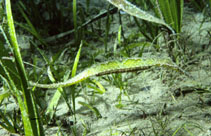| Family: |
Syngnathidae (Pipefishes and seahorses), subfamily: Syngnathinae |
| Max. size: |
29 cm TL (male/unsexed) |
| Environment: |
reef-associated; marine; depth range 0 - 10 m, non-migratory |
| Distribution: |
Indo-Pacific: Red Sea and Knysna, South Africa (Ref. 4281) to Samoa, north to southern Japan, south to New South Wales. |
| Diagnosis: |
Dorsal spines (total): 0-0; Dorsal soft rays (total): 38-48; Anal spines: 0-0; Anal soft rays: 4-4. Variable green to brown or grey, depending on habitat (Ref. 48635).
Description: Characterized by variable white and dark markings on body; absence of caudal fin; rings 15-18 + 40-54; continuous superior and inferior trunk ridge with respective tail ridges; inconspicuous inferior trunk ridge; dorsally deflected lateral trunk ridge behind anal ring, ends below superior tail ridge near rear base of dorsal fin; length of snout 1.7-1.8 in head length; depth of snout 5.3-7.8 in snout length; head length 4.9-6.3 in SL (Ref. 90102). |
| Biology: |
Occur in protected coastal shallows over or among algae, seagrasses (Ref. 41878), or floating weeds (Ref. 1602). Juveniles occasionally found near the surface (Ref. 4281). Ovoviviparous (Ref. 205). The males carry the eggs in a brood pouch which is found under the tail (Ref. 205). Used in Chinese medicine to extract Hailong, one of the important drugs (Ref. 12206). Has been reared in captivity (Ref. 35416). |
| IUCN Red List Status: |
Least Concern (LC); Date assessed: 26 August 2016 Ref. (130435)
|
| Threat to humans: |
harmless |
Source and more info: www.fishbase.org. For personal, classroom, and other internal use only. Not for publication.
